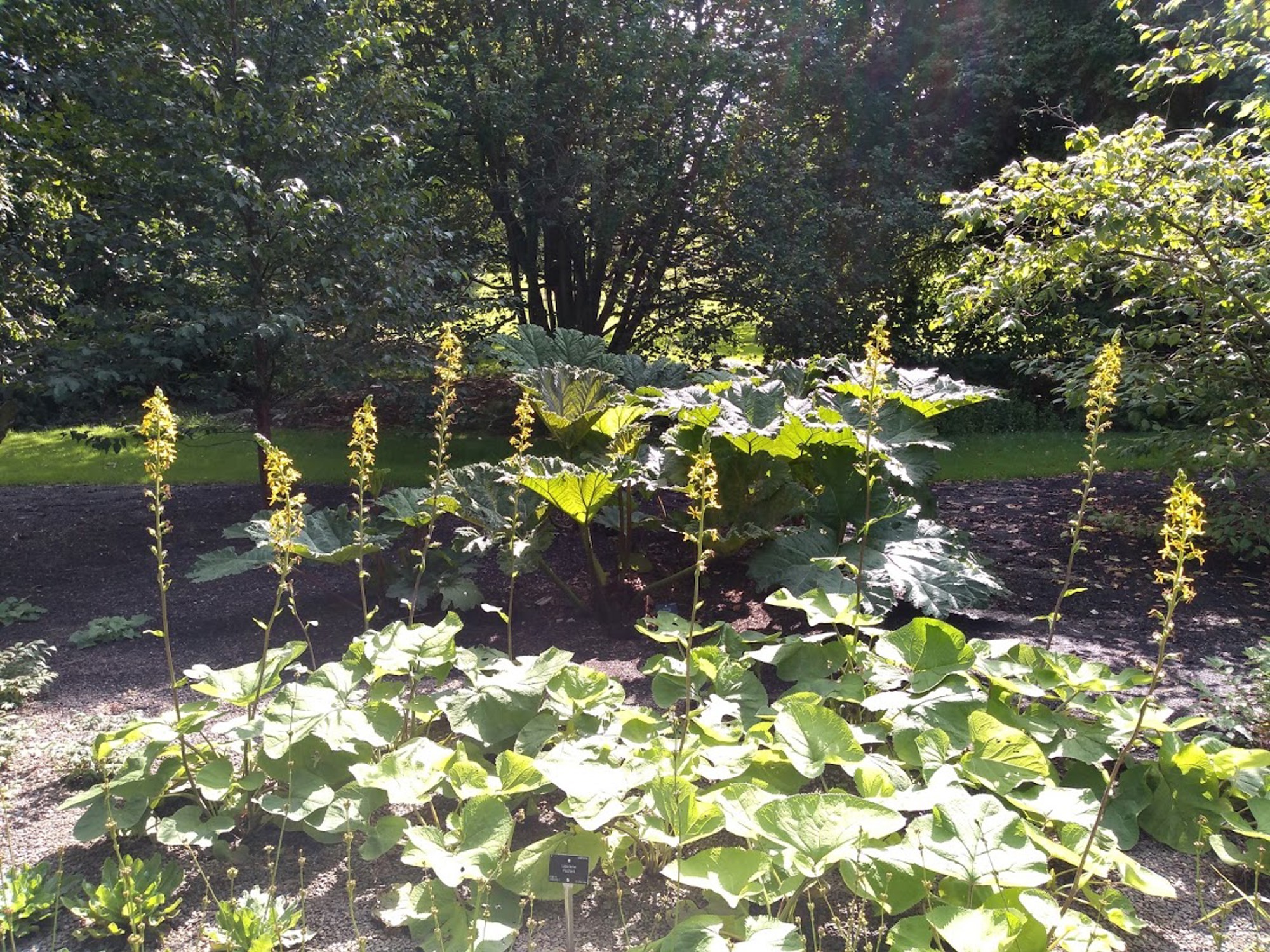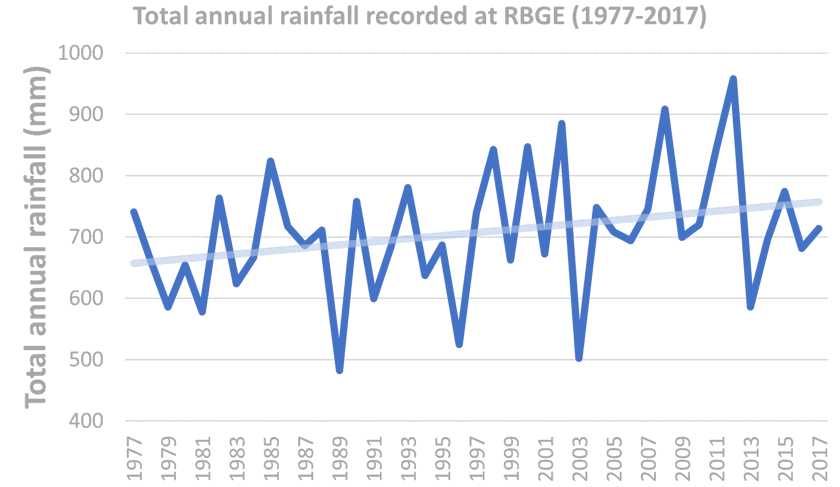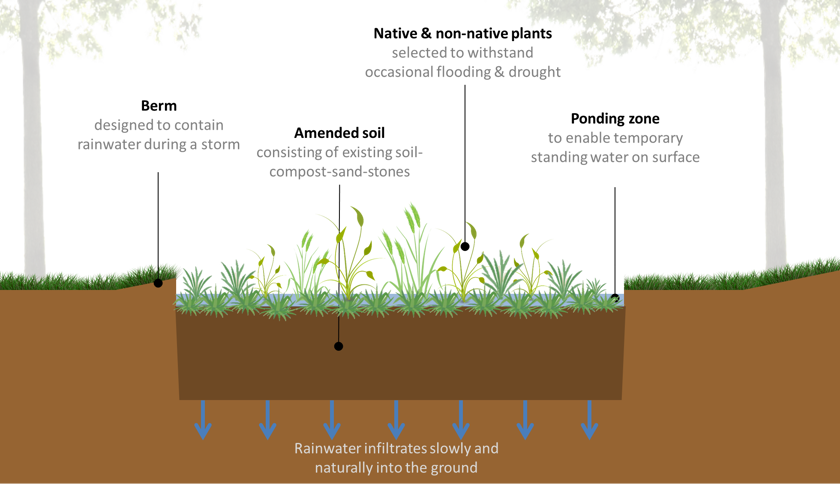
The Rain Garden
The climate is changing and rainfall is becoming more frequent and intense. Our Raingarden is an experimental garden adapted to meet the challenge of heavy rainfall events and to monitor their impact.
The rain garden
-
Info
The Rain Garden in 2022 -
Info
The Rain Garden in 2022 -
Info
The Rain Garden in 2022 -
Info
The Raingarden in 2019 -
Info
Bee on Knautia arvensis -
Info
Hosta sieboldiana and Primula poissonii in the Raingarden (2019) -
Info
Ligularia fischeri and Gunnera manicata in the Raingarden (2019) -
Info
Closeup of Cicerbita alpina flowers -
Info
Anthyllis vulneraria and Festuca altissima in the Raingarden (2019) -
Info
Ligularia fischeri in the rain garden (2019) -
Info
Waterlogging on the raingarden site (2018) -
Info
Flooded path near the Birch Lawn
More information
In Scotland, heavy rainfall is becoming more frequent and intense.

This graph shows the upward trend in rainfall over the last 40 years. With climate change likely to alter rainfall patterns and bring more heavy downpours, we expect flood risk to increase in the future.
The Botanics' Raingarden measures 20 metres long by seven metres wide and is located at the southside of the Garden. It is a shallow planted basin that naturally allows rainwater to drain into the ground.
The Garden's existing soil has been mixed with compost made on site as well as sand and fine gravel to a specified particle range size. The composition has been specifically developed for use in the Raingarden to allow for water infiltration but also to provide organic material and nutrients to support the plants.
The Raingarden features a selection of Scottish native plants and non-native plants many of which are known to soak up water and thrive in boggy areas. Plantings include primulas and hostas as well as the rare Alpine Sow Thistle Cicerbita alpina which can only be found on four sites in Scotland and is part of a conservation programme at RBGE.
The location, known previously as the Birch Lawn, had suffered historically from waterlogged lawns, submerged tree and shrub roots and flooded paths. Teams from RBGE and Heriot-Watt University will be using the Raingarden as a living laboratory, investigating the plants best placed to help the Raingarden thrive and monitoring how it performs during different rainfall events.
The Raingarden features a selection of Scottish native and non-native plants.
The selected Scottish native plants include: Succisa pratensis, Anthyllis vulneraria, Filipendula ulmaria, Knautia arvensis, Cicerbita alpina and Festuca altissima.
The selected non-native plants include: Aruncus gombalanus (China), Gunnera manicata (Brazil), Ligularia fischeri (E Asia), Aquilegia Formosa (Western N America), Primula poissonii (China), Rodgersia pinnata (China) and Hosta sieboldiana (Japan).
A number of established native and non-native trees were already growing at the Birch Lawn, including: Alnus glutinosa (native), Betula pendula (native), Corylus avelana (native), Quercus robur 'filicifolia' (cultivar of a native species), Alnus japonica (Japan), Alnus rubra (N America), Betula alleghaniensis (NE North America), Betula papyrifera (N North America), Betula nigra (USA), Corylussie boldiana (Japan, Korea), and Populus alba (S and central Europe).
As well as capturing water runoff, this shrub and perennial mix is perfect for encouraging and attracting a great diversity of wildlife to the area. The diversity of flowers will provide nectar sources for insects and bees. Leaving stems of the perennials and grasses standing over winter will provide a home for many invertebrates, as well as food for seed eating birds.

This project was developed by the Heriot-Watt University and RBGE as part of the Edinburgh Adapts - driving adaptation actions for the capital project, which aims to help the city adapt to the challenges of a changing climate.
The Raingarden was created in partnership with




More on the environment at the Garden
Botanics Recommends
-
Explore our range of unique gifts and more. Every purchase supports the Garden.
-
Explore our unique venues, suitable for every occasion
-
Discover a range of books inspired by the RBGE's work and collections
-
Cultivate your curiosity with our programme of courses for all ages and interests.
